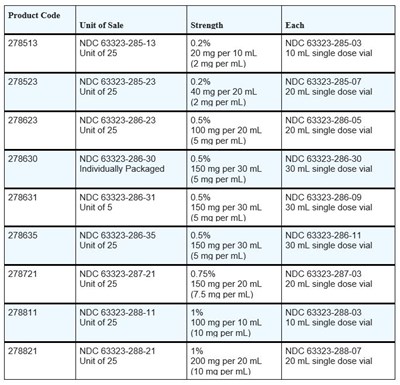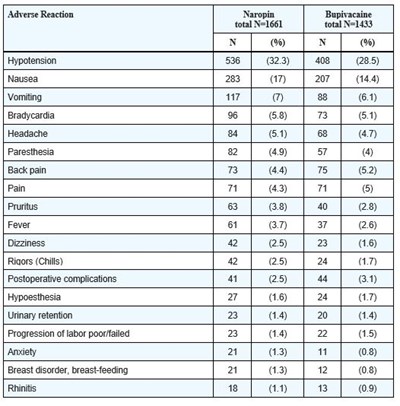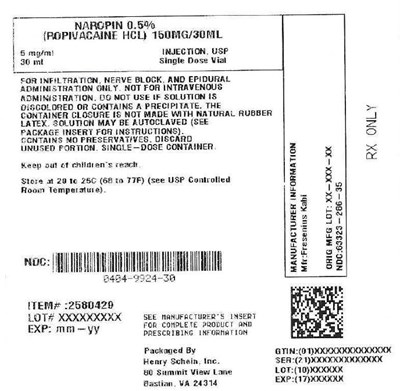Product Images Naropin
View Photos of Packaging, Labels & Appearance
Product Label Images
The following 14 images provide visual information about the product associated with Naropin NDC 0404-9924 by Henry Schein, Inc., such as packaging, labeling, and the appearance of the drug itself. This resource could be helpful for medical professionals, pharmacists, and patients seeking to verify medication information and ensure they have the correct product.
Image10.jpg - Image10

This is a dosage recommendation chart for the administration of Naropin for surgical anesthesia, labor pain management, and postoperative pain management. It includes recommended concentrations, volumes, and doses for various types of nerve blocks and epidural administrations. The chart also provides onset and duration times for each type of administration. Dosages for major nerve blocks vary depending on the site of administration and patient status, and supraclavicular brachial plexus blocks may have a higher frequency of serious adverse reactions. Cumulative doses up to 770 mg of Naropin over 24 hours have been well-tolerated in adults.*
Image11.jpg - Image11

This is a list of products with different product codes, unit of sale, and strength. It includes details such as NDC codes, quantity of vials in each unit of sale, and the concentration of the solution in mg per mL. Each product comes in single-dose vials and some of them are available individually packaged.*
Image2.jpg - Image2

This is a table presenting data from a meta-analysis of labor and delivery methods comparing the effectiveness of Naropin and Bupivacaine. The table displays the number and percentage of deliveries for each mode, including spontaneous vertex, vacuum extractor, forceps, and cesarean section. The data is also compared using a statistical test (p=0.004 versus bupivacaine).*
Image3.jpg - Image3

This text is a medical description of surgical anesthesia and acute pain management procedures. It mentions the use of an epidural block for surgery, including cesarean sections and major nerve blocks, as well as local infiltration. Additionally, it includes information about acute pain management techniques such as epidural continuous infusion or intermittent bolus, often used postoperatively or during labor.*
Image4.jpg - Image4

This is a table of different examples of drugs under various classes. The classes include Nitrates/Nitrites, Local anesthetics, Antineoplastic agents, Antibiotics, Antimalarials, Anticonvulsants, and Other drugs. Some examples of drugs under these classes are also listed.*
Image5.jpg - Image5

This is a record of adverse reactions to Bupivacaine, a medication used as a local anesthetic. The data shows a total of 1433 people experienced adverse reactions. The most common reactions were nausea, vomiting, and hypotension. The data also includes less common reactions such as headache, paresthesia, and urinary retention. The data is presented in a table with different parameters showing the number of individuals affected, as well as the percentage of the total group.*
Image6.jpg - Image6

This appears to be a table showing the incidence of adverse reactions associated with the use of Naropin Bupivacaine in pregnant women and neonates. The left column shows the adverse reactions reported in fetuses, while the right column lists the reactions recorded in neonates. The table shows the number of occurrences and the percentage of the total reported for each reaction. Some of the adverse reactions include fetal bradycardia, neonatal jaundice, Apgar score low, neonatal fever, and neonatal hypoglycemia.*
Image7.jpg - Image7

This is a table showing the incidence of adverse reactions to Naropin Bupivacaine at different concentrations, based on the number of patients (N) who experienced them. The reactions listed include hypotension, nausea, bradycardia, back pain, vomiting, headache, fever, chills, urinary retention, paresthesia, and pruritus. The percentages of patients who experienced each reaction are provided in brackets.*
Image8.jpg - Image8

This appears to be a chart showing the percentage of patients of different ages who received different dosages of Bupivacaine and Naropin. However, it is difficult to interpret without more context.*
Image9.jpg - Image9

This appears to be a table showing the adverse reactions and the percentage of female and male subjects who experienced each one in a study. The reactions include hypotension, nausea, bradycardia, vomiting, back pain, headache, chills, fever, pruritus, pain, urinary retention, dizziness, hypoesthesia, and paresthesia.*
Label1.jpg - Label1

This is a medication called NARGPIN 0.5%, which contains 150mg of ROPIVACAINE HCL per 30ml vial. It is to be used only for infiltration, nerve block, and epidural administration. The solution is not to be administered intravenously and should not be used if it has been discolored or contains a precipitate. The solution does not contain any preservatives, and the unused portion of the single-dose container must be discarded. The container does not have natural rubber latex material. It should be stored between 20 to 25°C. This medication is manufactured by Fresenius Kal with package insert for instructions. Lot number and NDC numbers are indicated. The rest of the text may contain typographical errors making it difficult to read.*
* The product label images have been analyzed using a combination of traditional computing and machine learning techniques. It should be noted that the descriptions provided may not be entirely accurate as they are experimental in nature. Use the information in this page at your own discretion and risk.


